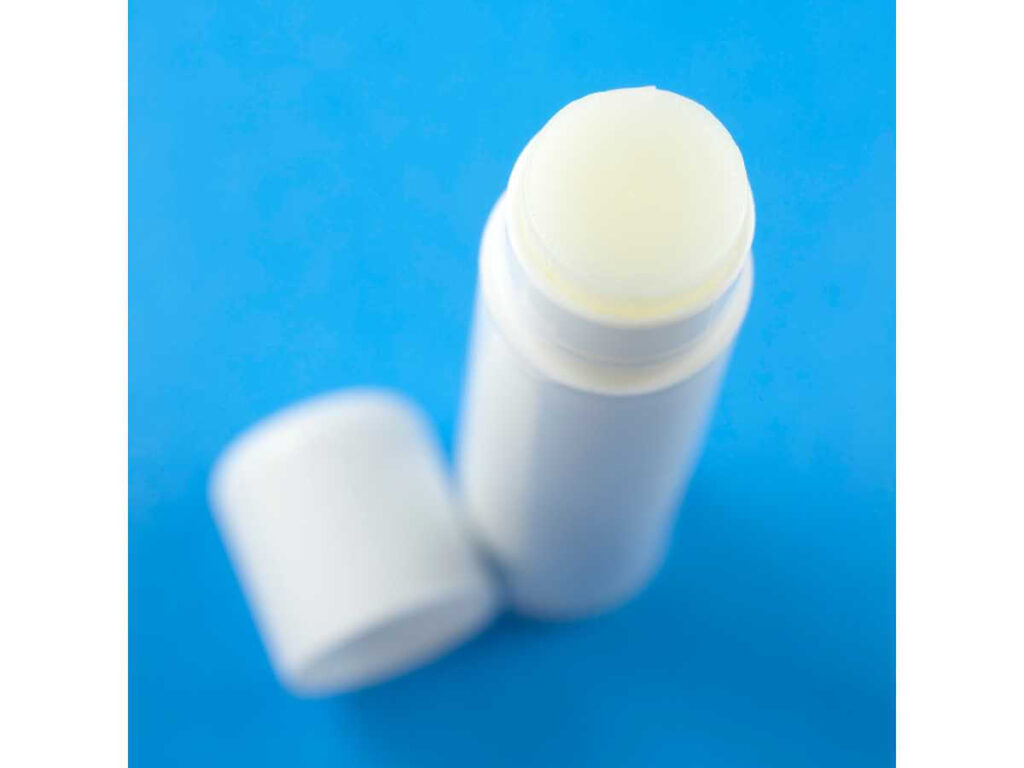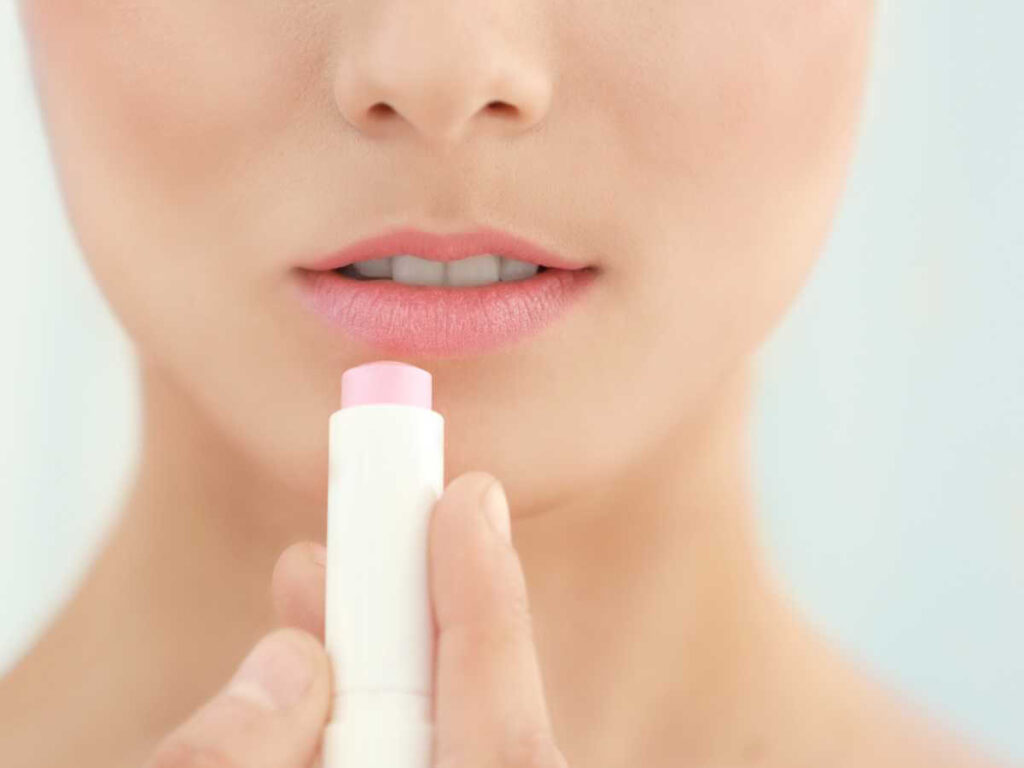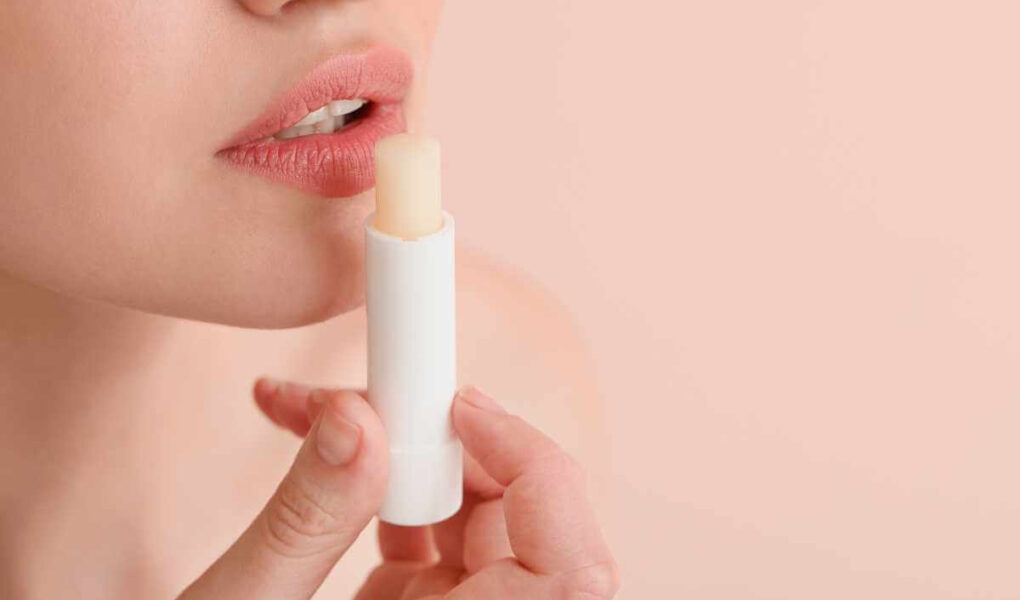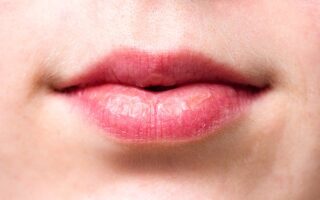During my long professional career, I often encounter clients and readers seeking answers to their most pressing beauty conundrums. One such question that has been on the lips of many is, “Does chapstick make your lips more chapped?” In our quest for the perfect pout, we may unintentionally exacerbate our lip woes by using products that promise relief.
In this captivating and insightful blog post, we will dive deep into the world of lip care, explore the science behind chapstick, and unveil the truth behind common lip balm misconceptions about whether or not your trusted lip balm could be causing more harm than good. Pucker up, and prepare to be enlightened!
What is Chapstick?

First, let’s go over what chapstick is.
Chapstick is a type of lip balm that helps keep your lips moisturized by locking in moisture and keeping out harsh environmental elements like the sun and the wind. It also prevents your lips from chapping and cracking.
Chapstick, often used as a generic term for lip balms, is a popular brand that has become synonymous with these moisturizing products. Lip balms, jelly balms, and other variations aim to soothe and protect the delicate skin on our lips. With a myriad of lip balm types available in the market, it’s essential to understand the purpose and functionality of these products. So, do these balms actually make your lips more chapped? Let’s unravel this mystery.
Find out “Is Chapstick Edible?“
The Purpose of Chapstick
Chapstick, or any lip balm for that matter, serves a dual purpose – to moisturize and protect your lips. Our lips, unlike the rest of our skin, lack oil glands, making them prone to dryness and chapping. This is where lip balms come in handy, providing the much-needed moisture and creating a protective barrier that shields our lips from harsh environmental elements. By understanding the purpose of Chapstick, we can better address the question of whether it makes your lips more chapped or not.
Moisturizing
Moisturizing is a crucial aspect of lip care, and lip balms, including Chapstick, are designed to restore and maintain the moisture balance in our lips. They usually contain ingredients such as beeswax, shea butter, and various oils that help keep our lips soft, supple, and well-nourished. However, not all lip balms are created equal. Some of them contain ingredients that can cause irritation, dryness, or allergic reactions, which may exacerbate chapped lips. As your skincare expert, I recommend reading labels carefully and selecting a lip balm with ingredients known to be gentle and moisturizing.
Protecting
Another vital function of Chapstick is to create a protective barrier on our lips, shielding them from environmental elements like cold, wind, and sun. Many lip balms contain ingredients that help form a skin barrier, locking in moisture and preventing water loss. Some balms even offer SPF protection, which is essential for preventing sunburn and long-term damage from UV rays.
While most effective lip balm products are designed to protect our lips, some might not be as effective as others, and even contain irritants that could make chapping worse. So, it’s crucial to choose a product that meets your specific needs and doesn’t cause irritation.
Chapstick Ingredients
Chapstick ingredients are typically a blend of wax, oil, and flavor. The most common waxes used in chapstick are beeswax and carnauba wax. The most common oils used are castor oil, coconut oil, and shea butter. The most common flavors are mint, cherry, and vanilla. Chapstick contains ingredients called “emollients” to prevent irritations and dry patches on your lips.
Chapsticks and lip balms often contain a blend of natural and synthetic ingredients, each with its own unique properties and benefits. Common lip balm ingredients are:
Natural Ingredients
Natural ingredients like beeswax, shea butter, and cocoa butter are popular choices in lip balms due to their moisturizing and nourishing properties.
Beeswax
Beeswax is a common ingredient in lip balms for its ability to create a protective barrier on the skin, sealing in moisture and helping to keep lips hydrated. Additionally, it has a smooth, sensorial experience that many users find appealing.
Shea Butter
Shea butter, derived from the nut of the African shea tree, is another emollient and humectant ingredient that helps keep lips moist and supple. Its high content of fatty acids and vitamins makes it an excellent choice for nourishing delicate lips.
Cocoa Butter
Cocoa butter, obtained from the seeds of the cocoa tree, also offers moisturizing benefits, thanks to its rich composition of fatty acids. Its creamy texture provides a luxurious feel to lip products, further enhancing the user experience.
Synthetic Ingredients
Not all synthetic ingredients in lip balms are harmful; however, some may cause irritation or dryness in certain individuals.
Petrolatum
Petrolatum, also known as petroleum jelly or mineral oil, is a widely used ingredient in lip balms due to its occlusive properties. It forms a barrier on the skin’s surface, preventing moisture loss. However, several experts and dermatologists, suggest that excessive use of petrolatum-based products could lead to a cycle of dryness, as the skin becomes dependent on the external source of hydration.
Parabens
Parabens are synthetic preservatives that help to extend the shelf life of lip balms and other cosmetic products. While they are generally considered safe in small amounts, some individuals may experience an allergic reaction or contact dermatitis. Ensure that you are not allergic, before applying.
Artificial Fragrances and Colors
Artificial fragrances and colors are added to the lip balms for aesthetic purposes. But it can also cause irritation and dryness in some people.
If you suspect that your chapstick may be causing your lips to become chapped, consider trying a fragrance-free, colorless lip balm to see if it improves your condition.
How Chapstick Works?
Have you ever wondered how that handy little tube of Chapstick works its magic on your lips? Well, let’s dive into the science behind it!
As we discussed above, chapstick or lip balm is formulated with a blend of waxes, oils, and other moisturizing ingredients that provide hydration and nourishment to the delicate skin on your lips. It works by sealing in the natural moisture of your lips, while also creating a protective barrier against environmental factors that can cause your lips to become dry and chapped.
As you know, the skin on your lips is quite thin and lacks the outer layers of skin that are present elsewhere on your body. This makes them more susceptible to losing moisture, leading to dryness and chapping. By applying Chapstick, you’re essentially creating a seal that traps your lip’s natural moisture, preventing it from evaporating into the air. Think of it as a cozy blanket for your lips, keeping them warm and protected from the cold, dry air that can sap them of their much-needed hydration.
Furthermore, Chapstick acts as a physical barrier between your lips and the outside world. The waxes and oils in the formula create a shield that protects the vulnerable layers of lip skin from potential irritants and damaging environmental factors, such as wind, cold temperatures, and UV rays. This barrier not only helps to prevent chapping but also aids in the healing process if your lips are already chapped or cracked. It’s like having a personal bodyguard for your lips, shielding them from harm and ensuring they stay healthy and beautiful.
In essence, it’s like a tiny suit of armor for your lips, defending them against the harsh elements and keeping them soft, smooth, and supple.
What Causes Chapped Lips?
Chapped lips are often a result of environmental factors, personal habits, or medical conditions that cause the lips to lose moisture, leading to dryness and cracking. Factors such as cold weather, winter, and exposure to harsh elements can trigger or worsen chapped lips. Additionally, trans-epidermal water loss, a process where the skin loses water to the surrounding air, can contribute to dryness. Other culprits include lip licking, which further dries the lips, and certain medical conditions that affect skin hydration.
Now, to the main question;
Does Chapstick Make Your Lips More Chapped?

Common Arguments Supporting the Claim
Ingredients Causing Dryness
Some dermatologists argue that certain chapstick ingredients may exacerbate chapped lips. These ingredients can cause irritation, leading to increased dryness and water loss.
Alcohol-Based Compounds
Alcohol-based compounds, found in some lip balms, can have a drying effect on the lips. As they evaporate quickly, they may leave the lips feeling drier than before, creating a vicious cycle of reapplication and worsening dryness.
Camphor and Menthol
Camphor and menthol, commonly used for their cooling and soothing effects, can be irritating to sensitive skin. Prolonged use of lip balms containing these ingredients may lead to increased dryness and chapping.
Overuse and Dependency
Another argument is that frequent use of chapsticks can create a dependency on lip balm, leading to what some call “lip balm addiction.” This psychological dependence may result in a perceived need for constant reapplication, further making chapped lips worse.
Counter-Arguments and Evidence
Role of personal habits and environmental factors
It’s essential to consider the impact of personal habits and environmental factors on lip health. Lip licking, exposure to harsh weather, and dehydration can all contribute to chapped lips. In many cases, using the right lip balm can help protect and nourish the lips, rather than causing further damage.
Lip licking
Lip licking is a common habit that can exacerbate chapped lips. Saliva contains enzymes that break down the skin’s protective barrier, making it more susceptible to dryness. Addressing this habit, along with using a suitable lip balm, can help improve lip hydration.
Exposure to harsh weather
Cold, dry weather can lead to chapped lips as the lips’ thin skin loses moisture more quickly. Using a lip balm containing ingredients like beeswax, shea butter, or petrolatum can help create a protective barrier and lock in moisture.
How to Choose the Right Chapstick for Your Lips?
Choosing the right chapstick for your lips is essential for maintaining healthy, moisturized lips. As a professional beautician, I recommend the following steps to ensure you’re using the best lip care product for your needs.
Identifying your specific lip care needs
To select the ideal lip balm, it’s crucial to identify your specific lip care needs. These may include:
Dryness:
If your lips are prone to dryness, look for a lip balm containing hydrating ingredients such as shea butter, cocoa butter, castor oil or hyaluronic acid.
Sun protection:
Exposure to the sun can lead to dry, chapped skin and increase the risk of skin cancer. To protect your lips, opt for a lip balm with at least SPF 30.
Sensitivity:
If you have sensitive skin or a skin condition like eczema, choose a fragrance-free, hypoallergenic lip balm to minimize the risk of irritation.
Selecting products with appropriate ingredients
Once you’ve determined your specific lip care needs, it’s essential to select a product containing appropriate ingredients.
Avoiding irritants:
Consult with a board-certified dermatologist to identify any ingredients that may be irritating to your lips. Common irritants include salicylic acid, camphor, and certain chemicals found in some lip balms.
Focusing on natural ingredients:
Natural ingredients, such as beeswax, coconut oil, and aloe vera, can provide a soothing and moisturizing effect without irritating the lips.
Testing the product and monitoring results
Before committing to a lip balm, it’s essential to test the product and monitor its effects on your lips. Use the lip balm for a couple of weeks, and observe any changes in your lip’s condition. If your lips become drier or more chapped, it may be the fault of the wrong balm, and you should consider trying a different product.
The Most Effective Lip Balm Ingredients
The most effective lip balm ingredients include shea butter, cocoa butter, hyaluronic acid, beeswax, coconut oil, and aloe vera. These ingredients help to moisturize and protect the lips without causing irritation or worsening chapped lips.
Lip Balm Ingredients to Avoid
Some lip balm ingredients can exacerbate dryness, cause irritation, eczema and allergic contact dermatitis. Ingredients to avoid include salicylic acid, chemical blockers and camphor in lip balm. Always consult with your board-certified dermatologist or skincare expert if you’re unsure about a specific ingredient’s safety. Also, limit lip balm with artificial flavors or scents.
Why do some lip balms make your lips more chapped?
Some lip balms may contain irritating ingredients that can make your lips drier and more chapped. These ingredients can cause a short-term soothing effect but may lead to long-term damage to the lips. It’s essential to choose a lip balm with moisturizing, non-irritating ingredients to avoid this issue.
Is it OK to use lip balm everyday?
Using lip balm every day can help to maintain healthy, moisturized lips, but it’s crucial to choose the right product. Opt for a lip balm that addresses your specific lip care needs and is free from irritating ingredients. Be sure to consult a dermatologist if you have any concerns or experience any adverse reactions to a lip balm.
Tips for Healthy and Hydrated Lips

To maintain healthy lip skin, it’s important to have a proper lip care routine that involves hydration, protection, and gentle exfoliation. Additionally, making certain lifestyle changes can help improve the overall health of your lips.
Lip care routine
A comprehensive lip care routine involves exfoliating, moisturizing, and protecting your lips from sun damage.
Exfoliating
Gently exfoliating your lips can help remove dead flaky skin cells, revealing smoother and more supple skin underneath. You can use a gentle chemical exfoliant, a soft toothbrush, a sugar scrub, or a specialized lip exfoliant. Remember to be gentle and avoid over-exfoliating, which can lead to irritation.
Moisturizing
Keeping your lips moisturized is key to preventing chapped lips. Look for hydrating skin care products containing ingredients like olive oil, emollient ointment, lip ointment, and healing ointments. These ingredients can help lock in moisture and keep your lips soft and supple. Apply lip balm regularly throughout the day, especially in colder or drier weather.
Protecting from sun damage
Sun damage can cause your lips to become chapped and even lead to premature aging. Make sure to use a lip balm with SPF to protect your lips from the sun’s harmful rays.
Lifestyle changes for better lip health
In addition to a proper lip care routine, making some lifestyle changes can have a positive impact on the health of your lips.
Staying hydrated
Drinking plenty of water is essential for healthy lips, as it helps maintain their natural moisture balance. Aim for at least eight glasses of water per day to keep your lips looking and feeling their best.
Avoiding lip biting and licking
Biting or licking your lips can strip away their natural oils, leading to chapped lips. Be mindful of these habits and try to avoid them whenever possible.
Using a humidifier
Using a humidifier in your home, especially during the winter months, can help maintain a comfortable level of humidity in the air. This helps prevent your lips from becoming overly dry and chapped.
How to Prevent Chapped Lips?
To help prevent chapped lips, try the following:
- Use chapstick sparingly. Don’t use it every time your lips feel dry or every time you need moisturization.
- Avoid chapstick and lip balms containing phenol, menthol, and salicylic acid ingredients.
- Avoid chapstick containing artificial flavors and scents.
- Use lip balms containing olive oil, petroleum jelly, cocoa butter, lanolin, and beeswax.
- Eat foods high in vitamin E like broccoli seeds, sunflower seeds, almonds, and hazelnuts.
- Use petroleum-based jelly products.
- Use chapstick and lip balm with SPF.
- Drink plenty of water.
In conclusion, while some chapsticks may cause your lips to become more chapped, a well-formulated product, combined with a comprehensive lip care routine and healthy lifestyle habits, can significantly improve the overall health of your lips. Remember to keep your lips moisturized, protect them from sun damage, and stay hydrated for the best results.


